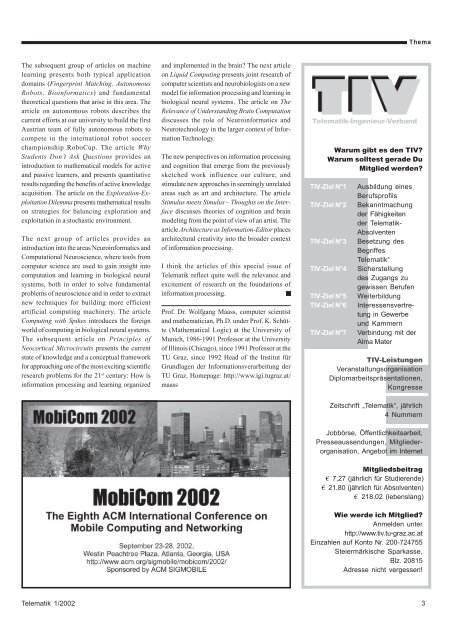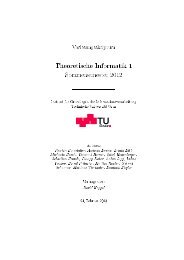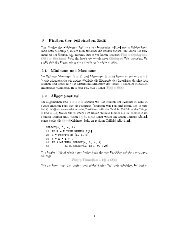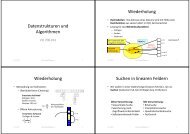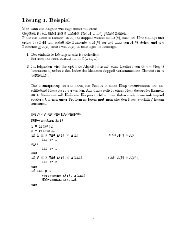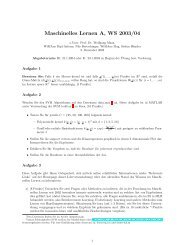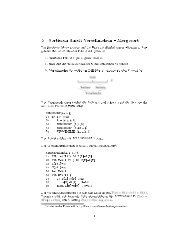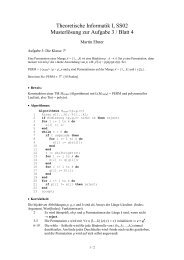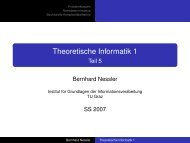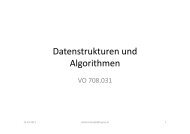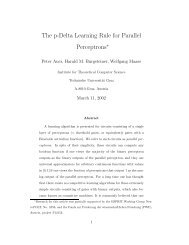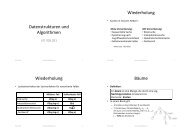Telematik 2/02 - Institut für Grundlagen der Informationsverarbeitung ...
Telematik 2/02 - Institut für Grundlagen der Informationsverarbeitung ...
Telematik 2/02 - Institut für Grundlagen der Informationsverarbeitung ...
Create successful ePaper yourself
Turn your PDF publications into a flip-book with our unique Google optimized e-Paper software.
The subsequent group of articles on machine<br />
learning presents both typical application<br />
domains (Fingerprint Matching, Autonomous<br />
Robots, Bioinformatics) and fundamental<br />
theoretical questions that arise in this area. The<br />
article on autonomous robots describes the<br />
current efforts at our university to build the first<br />
Austrian team of fully autonomous robots to<br />
compete in the international robot soccer<br />
championship RoboCup. The article Why<br />
Students Don’t Ask Questions provides an<br />
introduction to mathematical models for active<br />
and passive learners, and presents quantitative<br />
results regarding the benefits of active knowledge<br />
acquisition. The article on the Exploration-Exploitation<br />
Dilemma presents mathematical results<br />
on strategies for balancing exploration and<br />
exploitation in a stochastic environment.<br />
The next group of articles provides an<br />
introduction into the areas Neuroinformatics and<br />
Computational Neuroscience, where tools from<br />
computer science are used to gain insight into<br />
computation and learning in biological neural<br />
systems, both in or<strong>der</strong> to solve fundamental<br />
problems of neuroscience and in or<strong>der</strong> to extract<br />
new techniques for building more efficient<br />
artificial computing machinery. The article<br />
Computing with Spikes introduces the foreign<br />
world of computing in biological neural systems.<br />
The subsequent article on Principles of<br />
Neocortical Microcircuits presents the current<br />
state of knowledge and a conceptual framework<br />
for approaching one of the most exciting scientific<br />
research problems for the 21 st century: How is<br />
information processing and learning organized<br />
<strong>Telematik</strong> 1/20<strong>02</strong><br />
and implemented in the brain? The next article<br />
on Liquid Computing presents joint research of<br />
computer scientists and neurobiologists on a new<br />
model for information processing and learning in<br />
biological neural systems. The article on The<br />
Relevance of Un<strong>der</strong>standing Brain Computation<br />
discusses the role of Neuroinformatics and<br />
Neurotechnology in the larger context of Information<br />
Technology.<br />
The new perspectives on information processing<br />
and cognition that emerge from the previously<br />
sketched work influence our culture, and<br />
stimulate new approaches in seemingly unrelated<br />
areas such as art and architecture. The article<br />
Stimulus meets Simulus – Thoughts on the Interface<br />
discusses theories of cognition and brain<br />
modeling from the point of view of an artist. The<br />
article Architecture as Information-Editor places<br />
architectural creativity into the broa<strong>der</strong> context<br />
of information processing.<br />
I think the articles of this special issue of<br />
<strong>Telematik</strong> reflect quite well the relevance and<br />
excitement of research on the foundations of<br />
information processing.<br />
Prof. Dr. Wolfgang Maass, computer scientist<br />
and mathematician, Ph.D. un<strong>der</strong> Prof. K. Schütte<br />
(Mathematical Logic) at the University of<br />
Munich, 1986-1991 Professor at the University<br />
of Illinois (Chicago), since 1991 Professor at the<br />
TU Graz, since 1992 Head of the <strong>Institut</strong> <strong>für</strong><br />
<strong>Grundlagen</strong> <strong>der</strong> <strong>Informationsverarbeitung</strong> <strong>der</strong><br />
TU Graz. Homepage: http://www.igi.tugraz.at/<br />
maass<br />
<strong>Telematik</strong>-Ingenieur-Verband<br />
Thema<br />
Warum gibt es den TIV?<br />
Warum solltest gerade Du<br />
Mitglied werden?<br />
TIV-Ziel N°1 Ausbildung eines<br />
Berufsprofils<br />
TIV-Ziel N°2 Bekanntmachung<br />
<strong>der</strong> Fähigkeiten<br />
<strong>der</strong> <strong>Telematik</strong>-<br />
Absolventen<br />
TIV-Ziel N°3 Besetzung des<br />
Begriffes<br />
<strong>Telematik</strong>“<br />
TIV-Ziel N°4 Sicherstellung<br />
des Zugangs zu<br />
gewissen Berufen<br />
TIV-Ziel N°5 Weiterbildung<br />
TIV-Ziel N°6 Interessensvertretung<br />
in Gewerbe<br />
und Kammern<br />
TIV-Ziel N°7 Verbindung mit <strong>der</strong><br />
Alma Mater<br />
TIV-Leistungen<br />
Veranstaltungsorganisation<br />
Diplomarbeitspräsentationen,<br />
Kongresse<br />
Zeitschrift „<strong>Telematik</strong>“, jährlich<br />
4 Nummern<br />
Jobbörse, Öffentlichkeitsarbeit,<br />
Presseaussendungen, Mitglie<strong>der</strong>organisation,<br />
Angebot im Internet<br />
Mitgliedsbeitrag<br />
€ 7,27 (jährlich <strong>für</strong> Studierende)<br />
€ 21,80 (jährlich <strong>für</strong> Absolventen)<br />
€ 218,<strong>02</strong> (lebenslang)<br />
Wie werde ich Mitglied?<br />
Anmelden unter<br />
http://www.tiv.tu-graz.ac.at<br />
Einzahlen auf Konto Nr. 200-724755<br />
Steiermärkische Sparkasse,<br />
Blz. 20815<br />
Adresse nicht vergessen!<br />
3


